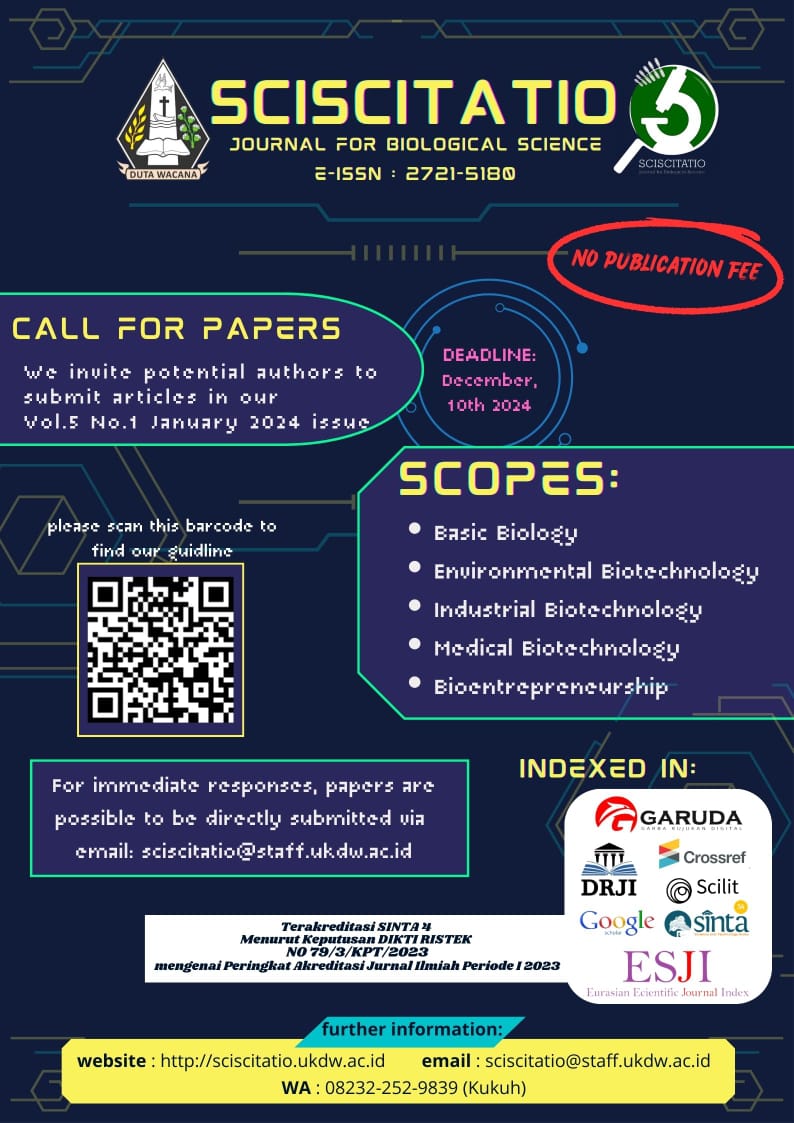The Potency of Corn (Zea Mays) Cob Waste as a Prebiotic Candidate to Support the Growth of Bifidobacterium longum: a Preliminary Study
DOI:
https://doi.org/10.21460/sciscitatio.2022.31.87Keywords:
Corn cob, prebiotic, Bifidobacterium longum, xylanAbstract
Corn cob is one of the most common agricultural wastes in Indonesia with high content of xylan. Xylan
can be used to produce xylitol which cannot be digested by human digestive enzymes thus, make it a potential
candidate of prebiotic. This preliminary research aimed to study the potency of corn cob in supporting the
growth of Bifidobacterium longum. Corn cob was produced into powder and used as the carbon source in the
growth medium of B. longum. Total plate count method was done to count the growth of B. longum in various
concentrations of bacteria solution. The result showed that crude corn cob powder can support the growth of
B. longum from bacterial enumeration with the value of 2.01 x 106 CFU/mL. The study indicated that corn cob
has a potential to be used as prebiotic.
References
Anonim. (1984). Official Method of Analysis. Association of Official Analysis Chemistry (AOAC), Washington, D. C.
Ariestanti, C. A., Seechamnanturakit, V., Harmayani, E & Wichienchot, S. (2019). Optimization on Production of Konjac Oligo-Glucomannan and Their Effect on the Gut Microbiota, Food Science and Nutrition, 7(2), 788–796. Available from: doi: 10.1002/fsn3.927.
Ameer, A. E. A., El-Salam, A. A. A. & Salem, A. S. (2014). Effect of Moringa oleiferaLeaves Extract as a Growth Factor on Viability of Some Encapsulated Probiotic Bacteria, World Journal of Dairy & Food Sciences, 9(2), 6–94. Available from: doi: 10.5829/idosi.wjdfs.2014.9.2.1134.
Connolly, M. L., Lovegrove, J. A. & Tuohy, K. M. (2010). Konjac Glucomannan Hydrolysate Beneficially Modulates Bacterial Composition and Activity Within the Faecal Microbiota, Journal of Functional Foods. Elsevier Ltd, 2(3), 219–224. Available from:doi: 10.1016/j.jff.2010.05.001
Davani-Davari, D., Negahdaripour, M., Karimzadeh, I., Seifan, M., Mohkam, M., Masoumi, S. J., Berenjian, A. & Ghasemi, Y. (2019). Prebiotics: Definition, Types, Sources, Mechanisms, and Clinical Applications, Foods, 8(3), 1–27. Available from: doi: 10.3390/
foods8030092.
Despres, J., Forano, E., Lepercq, P., ComtetMarre, S., Jubelin, G., Chambon, C., Yeoman, C. J., Miller, M. E. B., Fields, C. J., Martens, E.,Terrapon, N., Henrissat. B., White, B. A. & Mosoni, P. (2016). Xylan degradation by the Human Gut Bacteroides xylanisolvens XB1ATInvolves Two Distinct Gene Clusters that are Linked at the Transcriptional Level, BMC Genomics, 17(1), 1–14. Available from: doi: 10.1186/s12864-016-2680-8.
Eylen, D. V., Dongen, F. V., Kabel, M. & Bront, J. D. (2011). Corn Fiber, Cobs and Stover: Enzyme-Aided Saccharification and CoFermentation After Dilute Acid Pretreatment, Bioresource Technology. Elsevier Ltd, 102(10), 5995–6004. Available from: doi:10.1016/j.biortech.2011.02.049.
Fairus, S., Kurniawan, R., Taufana, R. & Nugraha, A. S. (2016). Kajian Pembuatan Xilitol dari Tongkol Jagung Melalui Proses Fermentasi, Al Kauniyah Jurnal Biologi, 6(2), 91–100.Gibson, G. R., Probert, H. M., Loo, J. V.,
Rastall, R. A. & Robertfroid, M. B .(2004). Dietary Modulation of the Human Colonic Microbiota: Updating the Concept of Prebiotics, Nutrition Research Reviews, 17(2), 259–275. Available from: doi: 10.1079/nrr200479.
Kongo, M. (2013). Lactic Acid Bacteria R&D for Food, Health and Livestock Purposes. Intechopen. Available from: doi: 10.1109/ICSESP.2018.8376691.
Lugani, Y. & Sooch, S. (2017). 8 - Xylitol, - an - Emerging - Prebiotic - a - Review, International journal of Applied Pharmaceutical and Biological Research, 2(2), 67–73.
Mardawati, E. Andoyo, R., Syukra, K. A., Kresnowati, M. T. A. P. & Bindar, Y. (2018). Production of Xylitol from Corn Cob Hydrolysate Through Acid and Enzymatic Hydrolysis by Yeast, IOP Conference Series: Earth and Environmental Science, 141(1). Available from: doi: 10.1088/1755-1315/141/1/012019.
Palframan, R., Gibson, G. R. & Rastall, R. A. (2003). Development of a Quantitative Tool for the Comparison of the Prebiotic Effect of Dietary Oligosaccharides, 281–284. Available from: doi: 10.1046/j.1472-765X.2003.01398.x.
Pennington, D. (2020). Bioenergy crops. Second EdS, Bioenergy: Biomass to Biofuels and Waste to Energy. Second EdS. Elsevier. Available from: doi: 10.1016/B978-0-12-815497-7.00007-5.
Pokusaeva, K., Fitzgerald, G. F. & Van Sinderen, D. (2011). Carbohydrate
Metabolism in Bifidobacteria, Genes and Nutrition, 6(3), 285–306. Available from: doi: 10.1007/s12263-010-0206-6.
Richana, N., Irawadi, T. T., Nur, M. A., Sailah, I., Syamsu, K. & Arkenan, Y. (2007). Ekstraksi Xilan dari Tongkol Jagung, Jurnal Pascapanen, 4(1), 38-43.Sarbini, S. R. & Rastall, R. A. (2011). Prebiotics : Metabolism , Structure , and Function, Metabolism Clinical And Experimental, 3(3), 93–106. Available from: doi: 10.2310/6180.2011.00004.
Sieuwerts, S., de Bok, F. A. M., Mols, E., de Vos, W. M. & van Hylckama Vlieg, J. E. T. (2008). A Simple and Fast Method for Determining Colony Forming Units, Letters in Applied Microbiology, 47(4), 275–278. Available from doi: 10.1111/j.1472-765X.2008.02417.x.
Schlegel, H. G. and Jannasch, H. W. (2006). Prokaryotes and Their Habitats, The Prokaryotes, 137–184. Available from:
doi: 10.1007/0-387-30741-9_6.
Soesetyaningsih, E. & Azizah. (2020). Akurasi Perhitungan Bakteri pada Daging Sapi Menggunakan Metode Hitung Cawan, Berkala Sainstek, 8(3), 75-79.
Sutton, S. (2012). The limitations of CFU: Compliance to CGMP Requires Good Science, The journal of GXP compliance, 16, 74–80.
Downloads
Published
How to Cite
Issue
Section
License
Copyright (c) 2022 THE AUTHOR(S)

This work is licensed under a Creative Commons Attribution-ShareAlike 4.0 International License.


